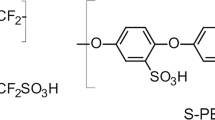Conclusions
-
1.
The effect of the C6F5 group on the ΝC=0 frequency of C6F5COR compounds depends on the structural features of the R fragment; for ketones, amides, and hydrazides there is steric inhibition of resonance in the C6F5CO group and an increase in the role of the inductive effect from C6F5.
-
2.
In N-dimethylpentafluorobenzamide the decrease in resonance is compensated by p,π-conjugation in the CON group, and the inductive effect of the C6F5 ring appears to be weaker than in pentafluoroacetophenone.
-
3.
The presence of the second nitrogen atom and the change in relative orientation of the unshared electron pair when affected by substituents at N1 and N2 in pentafluorobenzahydrazide molecules leads to an increase in the torsion angle in C6F5-CO in comparison to N-dimethylpentafluorobenzamide, which increases the -I effect of C6F5 on ΝC=0 in pentafluorobenzhydrazides.
Similar content being viewed by others
Literature cited
G. G. Furin, in: Reactivity of Polyfluoroaromatic Compounds [in Russian], Nauka, Novosibirsk (1983).
Spectral Atlas of Aromatic and Heterocyclic Compounds [in Russian], No. 1, Nauka, Novosibirsk (1967).
Spectral Atlas of Aromatic and Heterocyclic Compounds [in Russian], No. 2, Nauka, Novosibirsk (1976).
Spectral Atlas of Aromatic and Heterocyclic Compounds [in Russian], No. 14, Nauka, Novosibirsk (1977).
I. E. Korobeinicheva, A. V. Zibarev, G. G. Furin, and S. V. Dozmorov, Izv. Akad. Nauk SSSR, Ser. Khim., 122 (1981).
A. V. Zibarev, G. N. Dolenko, S. A. Krupoder, et al., Izv. Sib. Otd. Akad. Nauk SSSR, Ser. Khim.,73 (1980).
V. M. Vlasov and G. G. Yakobson, Zh. Org. Khim.,10, 573 (1974).
Yu. A. Zhdanov and V. I. Minkin, Correlation Analysis in Organic Chemistry [in Russian], Izd. Rost. Univ. (1966).
M. J. Aroney, G. Cleawer, B. K. Pierens, and R. J. M. Le Fevre, J. Chem. Soc. Parkin Trans. 2, 1851 (1976).
A. Perjessey, R. G. Jones, S. L. McClain, and Y. M. Wilkins, J. Org. Chem.,48, 1266 (1983).
G. I. Sarapulova, Dis. Kand. Khim. Nauk, Irkutsk (1985).
I. P. Bezhan, V. A. Khrustalev, K. N. Zelenin, and B. P. Nikolaev, Zh. Org. Khirn.,14, 754 (1978).
I. D. Kalikhman, E. N. Medvedeva, P. V. Makerov, and V. A. Lopyrev, Izv. Akad. Nauk SSSR, Ser. Khim., 2662 (1980).
E. V. Titov, Dis. Dokt. Khim. Nuak, Kiev (1973).
Author information
Authors and Affiliations
Additional information
Translated from Izvestiya Akademii Nauk SSSR, Seriya Khimicheskaya, No. 6, pp. 1322–1325, June, 1988.
Rights and permissions
About this article
Cite this article
Sarapulova, G.I., Volkova, L.I., Gostevskii, B.A. et al. Specific effect of pentafluorophenyl fragment on electronic state of carbonyl group in ketones, amides, and hydrazides containing a pentafluorophenyl group. Russ Chem Bull 37, 1162–1165 (1988). https://doi.org/10.1007/BF00961922
Received:
Issue Date:
DOI: https://doi.org/10.1007/BF00961922




